For a low FODMAP version of this healing kitchari recipe, that might be more appropriate for the IBS / SIBO set, you can find an updated recipe in my cookbook, SIBO Made Simple.
Some version of this healing kitchari recipe has been on rotation in my kitchen for years, ever since I began learning more about healing my autoimmune disease and writing books about it.
Whenever I’m coming back from a particularly glutinous vacation, or if my digestion is feeling stagnant, I turn to warming bowls like this one. It’s a great compliment to a full vice detox or any period of natural liver cleansing.
Kitchari, for those who aren’t familiar, is a flagpole recipe of healing Ayurvedic cuisine, and is said to be the best combination of nourishing foods that won’t tax your digestive system. If you’re not familiar with the philosophies and teachings of this ancient medicine, I highly recommend listening to my interview on the podcast which tackles the Ayurvedic approach to gut health and pesky weight fluctuations.
What is Kitchari?
Kitchari is traditionally made from either yellow lentils or split peas, basmati rice, a mixture of digestive spices, and ghee. With Paleo-ism on the rise, I know this might seem strange to some of you. Aren’t legumes and grains hard to digest?
Why is Kitchari healing for the digestive system?
The theory behind this dish’s efficacy has a lot to do with the concept of food combining. A mono-nutrient fast gives our digestive systems a much-needed break from dealing with a mess of different foods every meal. The dal and rice is cooked until just short of mush, so it’s easier to absorb. The spice mix fires up our belly, and the ghee (or coconut oil) helps lube up your tubing and allows fat-soluable nutrients to assimilate.
This kitchari recipe, which is adapted from Leah Vanderveldt’s fabulous book The New Nourishing, is also packed with greens for added fiber, vitamins and minerals. This may go against the grain (literally and figuratively) of the traditional recipe, but since the veggies are also cooked down until quite soft, it isn’t too taxing on your system and makes the kitchari recipe more of a complete meal.
Is Kitchari Low FODMAP?
Even though one of the main ingredients is a legume, this dish is actually fairly easy to adapt to a low FODMAP diet. In fact, I have a recipe for low FODMAP brown rice kitchari in my new book, SIBO Made Simple.
Working from this kitchari recipe, simply double the rice and skip the split peas or lentils, and limit the broccoli to 2 cups. The mixture doesn’t have onion or garlic, so for once, you’re covered in that department. And you can serve without the yogurt topping.
In fact, traditional kitchari is a subtle nod to what many of us who have experimented with a low FODMAP diet know: that onion and garlic can be irritating for many people. It’s no surprise that they are omitted as part of the therapeutic aspects of this dish.
What Makes Kitchari the Best Detox Recipe?
I got into depth here about natural ways to detox and how food fits into the picture. You can find a list of my favorite detox ingredients there, many of which are included in this kitchari recipe.
One of my favorite cleansing herbs is cilantro, which is an all-star chelating agent. If you’re doing a liver detox or even a period of SIBO treatment, I highly recommend adding a few handfuls of leaves to your finished dishes or pureeing it into soups. So for both flavor and health benefits, I think it’s the perfect things to garnish your bowl of green kitchari.
5 Star Reader Review
“Amazing version of kitchari! I’ve made it 3 times, each a little different. That’s the beauty of this recipe you can be very creative / flexible with amazing results. Add the vegetables you like and/or best for your dosha.”
—Matt
This recipe is naturally vegan, dairy free, gluten free, nut free, and soy free. But some people also will add a dollop of plain unsweetened yogurt for a probiotic boost. I try to steer clear of dairy whenever I’m doing a liver detox or healing my digestion, but a coconut yogurt would work well.
Finally, this recipe is quite plain on purpose, just using fresh ginger and digestive spices like turmeric, coriander, cumin, fennel seeds and fenugreek. As I mentioned above, there’s purposely no alliums and no hot or spicy ingredients beyond the slight heat of the ginger. BUT if you’re just enjoying this recipe as a healthy dinner and not a cleanse, I will say that a dash of hot sauce or chili crisp makes it all the more delicious. Don’t shoot the messenger!
All in all, this kitchari recipe could not be easier. Since you’re cooking the rice and lentils in so much liquid, it’s hard to screw it up. If you find that your grains are too dry and they aren’t fully soft yet, just add more water. It benefits from some degree of experimentation and feel, but is also hard to screw up.
If you have any health woes that you’re planning on tackling, my meal plans might be the perfect way to approach them together. Kitchari is a fantastic pantry option, as are some of the recipes in my pantry planner. You can find more recipes for detoxing your liver here.
With health and hedonism,
Phoebe
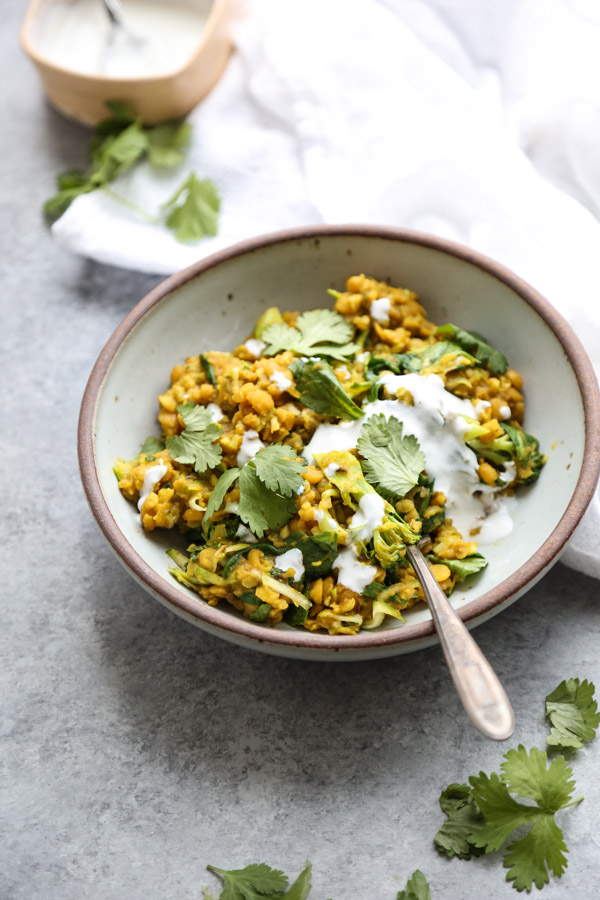
Ayurvedic Cleansing Green Kitchari Bowl
Ingredients
- 1 cup dried yellow split peas or lentils
- 1/2 cup long grain brown rice
- 3 tablespoons ghee or coconut oil
- 1 tablespoons grated fresh ginger
- 2 teaspoons ground cumin
- 1 teaspoon ground coriander
- 1 teaspoon fennel seeds
- 1 teaspoon ground fenugreek
- 1 teaspoon ground turmeric
- 1 teaspoon sea salt
- 5 cups vegetable stock or water
- 1 small crown broccoli finely chopped into an almost rice-like texture (about 2 cups total)
- 1 medium zucchini coarsely grated (about 1 cup)
- 1 cup packed baby spinach roughly chopped
- 1/4 cup cilantro leaves
- Plain full-fat Greek yogurt for serving
Instructions
- Rinse the yellow split peas or lentils and rice in a fine mesh colander under cold water until the water runs clear.
- In a large lidded saucepan over medium-high heat, heat the coconut oil or ghee. Add the ginger and cook, stirring, for 30 seconds. Add the cumin, coriander, fennel seeds, fenugreek, and turmeric. Cook for another 30 seconds, until fragrant.
- Add the split peas or lentils and rice and stir to coat in the spices. Add the salt and pour in the water or vegetable stock. Bring to a boil, cover, and reduce the heat to medium-low. Simmer for 35-45 minutes, stirring occasionally, until the peas/lentils are tender but not mushy and most of the liquid has been absorbed. (You may need to add more water if the mixture becomes to dry or begins to stick to the bottom of the pan).
- Stir in the broccoli. Cover and cook for another 4-5 minutes. Stir in the zucchini and spinach, then remove from the heat and leave to stand for 5 minutes. Serve warm scattered with the cilantro and plain yogurt, if desired.
Notes
Need help finding lifestyle changes that last? Let’s work together to find your path forward. My 4 Weeks to Wellness Course might just change your life. With 4-weeks worth of recipes that are gluten, dairy, corn, soy and refined sugar free, not to mention tasty AF, it’s a perfect way to explore your food sensitivities and heal inner and outer chaos.
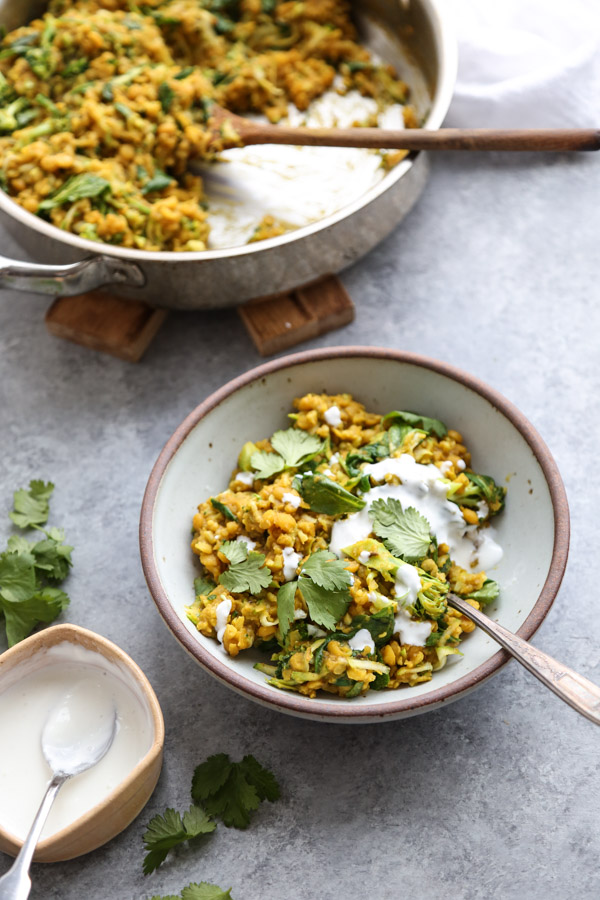
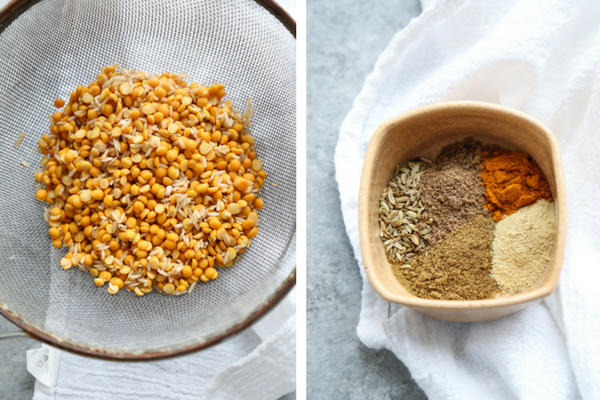
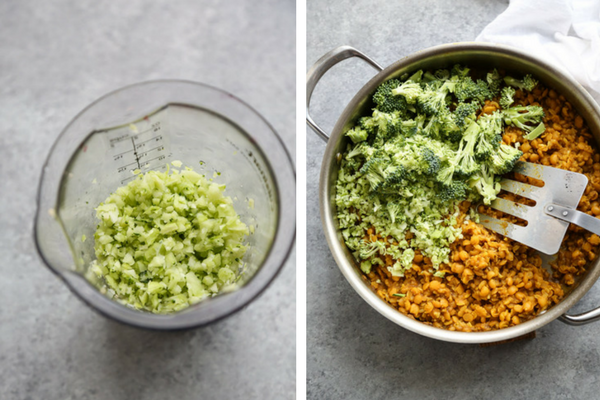

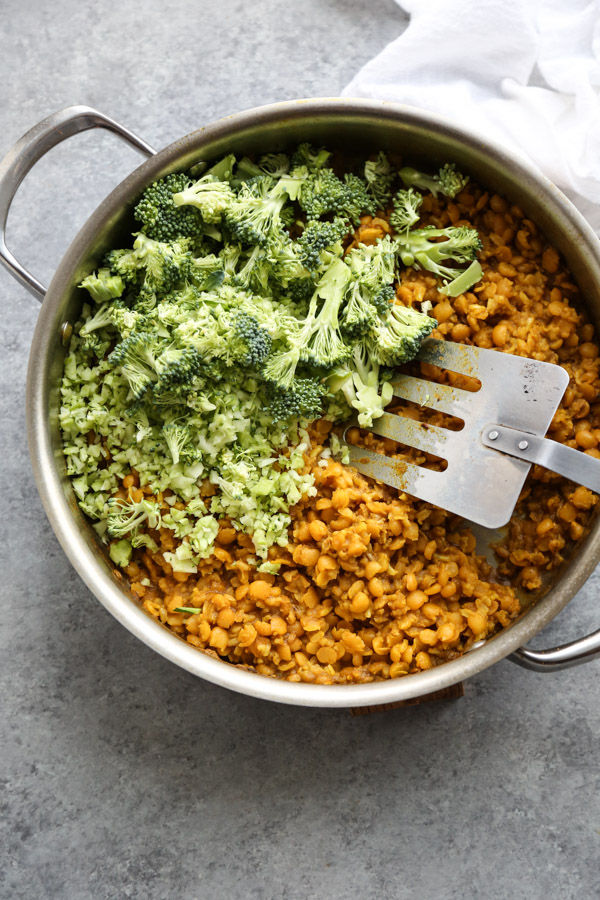
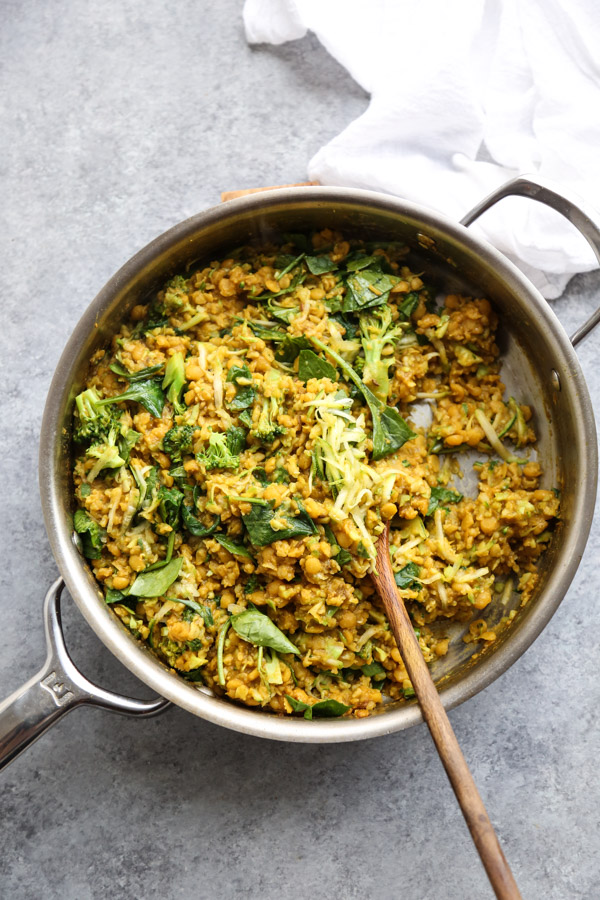
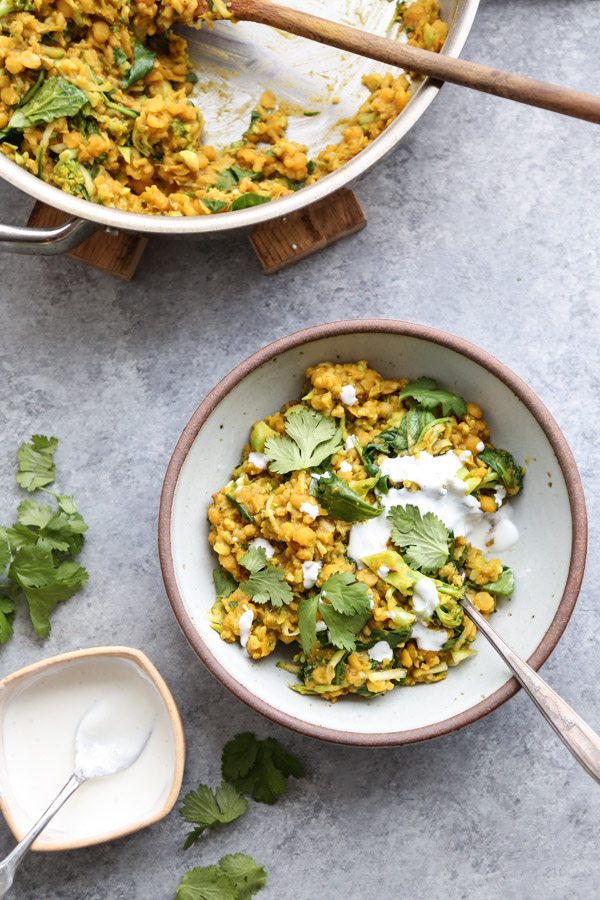
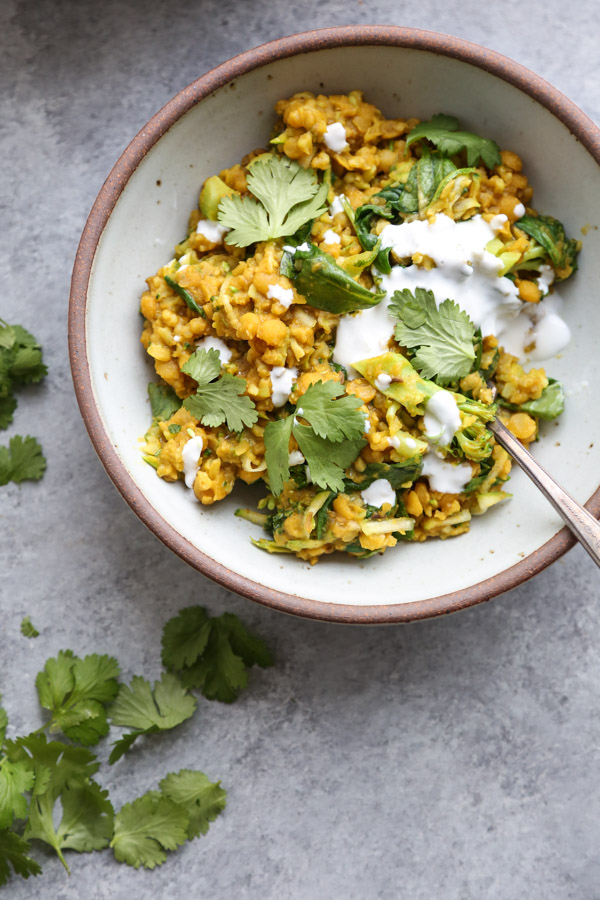
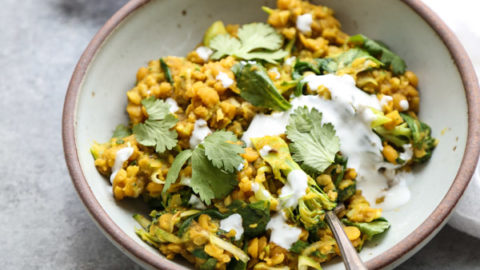

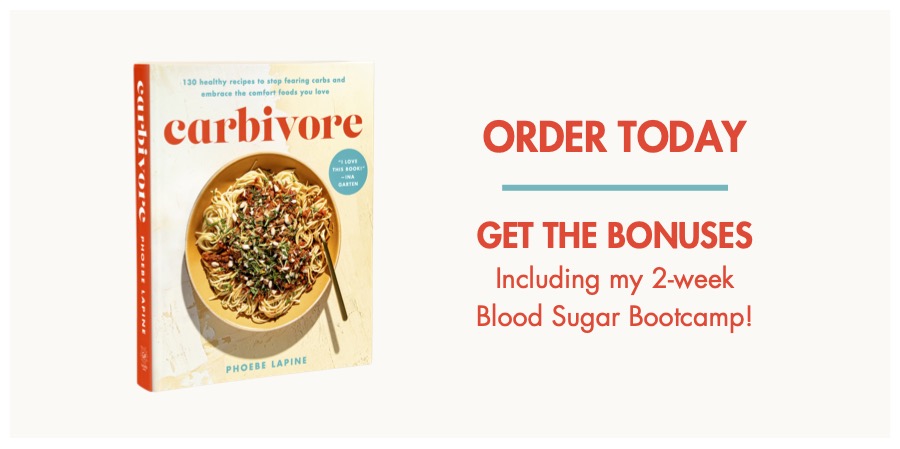
I have a tempestuous tum-tum, so I live on fennel tea. I’m never sure how to use it in cooking, so I don’t – but this recipe makes me see how. Will try for certain!
it’s wonderful in this recipe!
I found the recipe quite tasteless. After making it according to the recipe, I added a lot more salt and ghee to try to pull out some flavour. I’d switch to a more traditional yellow Dahl next time. Sorry to sound so critical but I was disappointed with how “western” it tasted.
I made this tonight, the flavours were delicious, unfortunately the liquid did not absorb by the 40 minutes…i continued to cook, uncovered longer and then removed some liquid to continue…can i please check is the simmering for 35-40 should be uncovered? I’m sure it would have been a beautiful dish if I had perfected it, i wish the dish had been chunkier, mine was quite mooshy.
Sorry to heat that Rachelle! The instruction’s from the book are covered for 35-45 minutes, and when I tested it myself that was right on. The lentils and rice should be tender and perhaps slightly more well done than usual, but not overly mushy. What type of rice did you use? If it was a quicker cooking option that could be it.
Thanks Phoebe, I used brown rice but it was a shorter grain. I’ll definitely try and make again, my Fiance came to tell me dinner was nice and usually i have to pester him for a compliment haha
well, that’s a WIN!
I made this today and omg!! Love love love!
If I soak the lentils overnight, how should I adjust the recipe?
They might cook quicker, so I’d start with less liquid (maybe 4 cups) and add more as you cook if needed.
What can one use instead of fenugreek if i cannot find it?
i would simply omit. the other spices are wonderful.
Lovely recipe, thanks! I love the addition of healthy veggies. In place of regular lentils in kitchari I always use urad dal (can be ordered online). The Monash University tested lentils and found that chana and urad/urid dal are low FODMAP.
that’s very good to know – thanks!!
thank you! Seems important for kitchari to have the protein otherwise it is essentially rice!?!!
“A mono-nutrient fast gives our digestive systems a much-needed break from dealing with a mess of different foods every meal. The dal and rice is cooked until just short of mush, so it’s easier to absorb. The spice mix fires up our belly, and the ghee (or coconut oil) helps lube up your tubing and allows fat-soluable nutrients to assimilate.”
Recipe looks tasty, and not to be argumentative, but is there is any literature about any of this? What exactly does “fire up our belly” mean and why is that beneficial? Have you seen evidence that eating ghee/coconut oil improves fat-soluable nutrient absorption? I have not.
I ask these questions as a medical doctor who frequently sees such hyperbole on a variety of health sites, but with little scientific data to rely on. Thanks.
The fire is in relation to Ayurveda and what foods have a fire tendency. Ayurveda is quite an old style of medicine from India, which quite a bit of literature to support how it benefits the body. There may not be information in specifics as to why it helps; but in the same tone in modern medicine we have thought we had answers that we didn’t necessarily have either. For some, they research it and if it works for them they use it and if not they don’t.
As far as coconut oil helping absorb fat soluble nutrients, that’s known squarely within western medicine. Black tea for instance is water soluble so we heat water and steep the tea so as to ingest the tea better. Same thing with fat soluble nutrients; it is much easier to absorb them with the presence of fats to bind to.
It’s really nice to find a recipe that doesn’t call for onion or garlic. My only caution would be for people to be aware that almost all vegetarian broths contain allium of some kind or another. Additionally, for those who are GF, please be careful with premade kitchari spices. Most contain asofoetida (hing) – used in place of onion or garlic, however, very often it is cut with wheat. Look for a product that is certified gf and uses gram (chickpea) flour instead.
interesting to know about the premade spices!
This was delish! I didn’t have fenugreek so I used mustard seeds and added a pinch of hing. Since it’s the dead of winter where I am, instead of zucchini, I used grated kohlrabi, which worked great!
I don’t have any brown rice in the house, would long-grain white rice, wild rice, or quinoa work instead?
Really nice recipe. This is the third time I’ve cooked it for my family and all the times they have ẹnoyed it so much. It’s worth a try for someone considering it.
Spices and everything are on point! I used red lentils and sadly with the ‘occasional stirring’ they turned mushy. With swap for something else in the future!
On point. it is 4th time i tried your recipe. I missed few ingredients and put mustard seeds and added a pinch of hing. Still good. Thanks
Just try this recipe today so delicious!!! Comfort food specially tonight cold and rain
Wow!!!! Just made this and it is so delicious! Made it with Chana Dahl instead of split yellow peas and worked great. So much flavour! Thanks for the recipe 🙂
Amazing version of kitchari! I’ve made it 3 times, each a little different. That’s the beauty of this recipe you can be very creative / flexible with amazing results. Add the vegetables you like and/or best for your dosha.
so glad you enjoyed!
Looks so delicious, My entire family loved it, I will definitely try it your way, thank you for sharing. Looking forward to seeing more recipes. I’ll be back.
i’m so glad!!
Kitchari has been among our family for quite a long time. but your recipe made it a full-fledged dish for me.
I make this for breakfast every day! My 5yo son says ‘Kitchadi is may favourite food’, even though he complains when I add broccoli. I feel like it’s a magical start to the day. Thanks so much for sharing this recipe!
amazing!! love that you do it for breakfast!
Loved this!! So much depth of flavour. Added a squeeze of lime at the end rather than the yoghurt. Would absolutely make again. Thanks!
Hi! Do you think this recipe is Instant Pot friendly? I feel I digest lentils better when they’re cooked that way. Thanks!
This was delish! I didn’t have fenugreek so I used mustard seeds and added a pinch of hing. Since it’s the dead of winter where I am, instead of zucchini, I used grated kohlrabi, which worked great!
My favorite kitchari recipe ever!! Due to a kidney disease, I do need the nutrient values though. The kitchari values I look up vary greatly! Is there a big difference in calories between using ghee or coconut oil? I basically need carbs, fats, protein and salt. I prepare enough for 8 one cup servings. Please respond with the finished dish nutrient values. Thank you.
If I soak the lentils overnight, how should I adjust the recipe?
Have you ever tried this with Native American Wild Rice. hand harvested, hand parched. Try Nett Lake. MN
I haven’t! I usually cook wild rice in a pot with lots of water so not sure it would work as a pilaf like this recipe
Ok I used basmati rice and mong beans and it was slightly mushy. Lovely flavor
it is definitely meant to me on the mushy side!
I didn’t! I often prepare wild rice in a saucepan with a lot of water, so I’m not sure if this recipe’s pilaf version would work.
Wonderful! I regularly follow your website and learn a lot of delicious and nutritious food. This dish is very good for the digestive tract and my whole family loves it. I always look forward to new recipes from you.
I’m not sure if the pilaf version of this dish would work because I usually cook wild rice in a saucepan with a lot of water.
@rocket soccer derby
I will try it, but I’m afraid it’s easy to gain weight
Would like to made it for a group of 25 meditators…can it be adjusted for multiplying for that many people? Thank you
Yum! I made this after dental surgery hoping that it would be both easy to eat and calming for my stomach after all of the meds. It won on both fronts! Very delicious and comforting. My new go-to healing comfort food!
so glad you enjoyed!
Thanks for the amazing recipe, My family really like it.
You can use devices like Personal computers (PC), laptops, tablets, Smart Watches, Androids, Macbooks, iPads, and iPhones to login into your hotmail
l account.
I’m obsessed with this! My friend Rose showed it to me and I’ve made it several times. My GI system is sensitive and I deal with constipation often, this is so tasty and it helps! I don’t understand the negative reviews. Thank you so much a for a delicious healthy recipe! Will def be back 🙂
thanks for reporting back! So glad you’ve enjoyed it
I am a fan of your website, here you have shown me a lot of my favorite dishes, thanks!
This was bloody delicious. Have made it many times
This blog is really cool, I’m so lucky that I have reached here and got this awesome information.
Hi
I was wondering if I could use quinoa instead of brown rice. Rice sends my blood sugars thru the roof. Thanks
yes you can try it!
The first time I made this I thought there was too much moisture. The next time I used 4 cups of broth in the beginning and then added another 1/2 to 3/4 when I added the broccoli and zucchini.
Fantastic recipe! Absolutely delicious.
I’ve tried this recipe twice and both times it was a failure. The peas are hard while the rice is mooshy, even with soaking. Proportions and cooking times are way off
Are you using split red or yellow lentils / peas? If they are whole that might be the problem. You want to choose one that is a 15ish minute cook time.